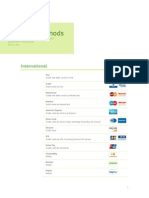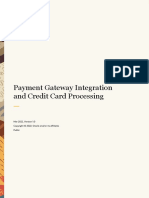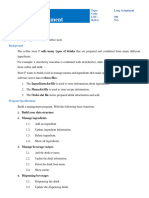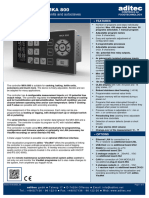Payment Gateways
Payment Gateways
Uploaded by
Anmol AgarwalCopyright:
Available Formats
Payment Gateways
Payment Gateways
Uploaded by
Anmol AgarwalCopyright
Available Formats
Share this document
Did you find this document useful?
Is this content inappropriate?
Copyright:
Available Formats
Payment Gateways
Payment Gateways
Uploaded by
Anmol AgarwalCopyright:
Available Formats
The following types of electronic payments are most common today.
That
said, it is important to realize that new payment types are continual being
discovered and there are additional methods that exist or are being
developed continuously.
Cards
Credit cards, debit cards and prepaid cards currently represent the most
common form of electronic payments. For all 3 types of cards the consumer
or the business most often uses a plastic card, commonly with a magnetic
stripe. The cardholder gives his or her card or card number to a merchant
who swipes the card through a terminal or enters the data to a PC. The
terminal transmits data to his or her bank, the acquirer. The acquirer
transmits the data through a card association to the card issuer who makes
a decision on the transaction and relays it back to the merchant, who gives
goods or services to the cardholder. Funds flow later for settlement with
credit cards and are debited immediately for debit or pre-paid cards.
Along with magnetic stripe cards, smart cards are and will increasingly be
used for payments. Smart cards are at present overwhelmingly plastic
credit cards with an embedded computer chip. Until recently, many smart
cards operated using proprietary rather than common standards. A
standard set of specifications, EMV, has been developed and is being used
increasingly so that the chips on smart cards are interoperable. Korea and
Japan are among the most advanced countries in Asia for smart card
payments, with Malaysia catching up fast due to government mandates for
banks to issue smart cards. Most credit and debit cards are expected to be
issued or reissued as smart cards by 2008 or earlier.
Over time, the chip for payment can be expected to move onto other
devices. A smart card might then become the computer chip in a phone,
PDA or other device that can perform the same function as chip in a plastic
card, eliminating the need for the actual plastic card. Smart cards could
thus evolve into smart phones, smart PDAs or other smart devices.
Internet
Online payments involve the customer transferring money or making a
purchase online via the internet. Consumers and businesses can transfer
money to third parties from the bank or other account, and hey can also
use credit, debit and prepaid cards to make purchases online.
Current estimates are that over 80% of payments for online purchases are
made using a credit card or debit card. At present, most online transactions
involve payment with a credit card. While other forms of payment such as
direct debits to accounts or pre-paid accounts and cards are increasing,
they currently represent a less developed transaction methodology.
Mobile Payments
Mobile phones are currently used for a limited number of electronic
transactions. However, the percentage seems likely to increase as mobile
phone manufacturers enable the chip and software in the phone for easier
electronic commerce.
Consumers can use their mobile phone to pay for transactions in several
ways. Consumers may send an SMS message, transmit a PIN number,
use WAP to make online payments, or perform other segments of their
transaction with the phone. As phones develop further, consumers are
likely to be able to use infrared, Bluetooth and other means more frequently
to transmit full account data in order to make payments securely and easily
from their phone.
Additionally, merchants can obtain an authorization for a credit or debit
card transaction by attaching a device to their mobile phone. A consortium
in the US also recently announced PowerSwipe, for example, which
physically connects to a Nextel phone, weighs 3.1 ounces, and
incorporates a magnetic stripe reader, infrared printing port, and pass-
through connector for charging the handset battery.
Financial Service Kiosks
Companies and service providers in several countries, including Singapore
and the US, have set up kiosks to enable financial and non-financial
transactions. These kiosks are fixed stations with phone connections where
the customer usually uses a keyboard and television-like screen to
transaction or to access information.
At AXS stations in Singapore, for example, consumers can make electronic
bill payments, send email or SMS message and make phone calls. Kiosks
in the United States enable the customer to send money via wire transfers,
cash checks, make purchases using cash, and make phone calls.
Located at convenient public locations such as bus or subway stations,
convenience stores or shopping malls, these kiosks enable electronic
payments by individuals who may not have regular access to the internet or
mobile phones.
Television Set-Top Boxes and Satellite Receiver
Specialized boxes attached to a television can also be used for payments
in some locations. The set-top box attaches to the television and a
keyboard or other device, and customers can make purchases by viewing
items on the television. Payment is made electronically using a credit card
or other account. While usage is presently low, it could grow substantially in
countries with a strong cable or satellite television network.
Biometric Payments
Electronic payments using biometrics are still largely in their infancy. Trials
are underway in the United States, Australia and a limited number of other
countries. Most biometric payments involve using fingerprints as the
identification and access tool, though companies like Visa International are
piloting voice recognition technology and retina scans are also under
consideration. Essentially, a biometric identifier such as a fingerprint or
voice could replace the plastic card and more securely identifies the person
undertaking the transaction. The electronic payment is still charged to a
credit card or other account, with the biometric identifier replacing the card,
check or other transaction mechanism.
Electronic Payments Networks
Various countries have electronic payments networks that consumer can
use to make payments electronically. ACH (Automated Clearing House) in
the US, domestic EFTPOS networks in Australia and Singapore, and other
networks enable electronic payments between businesses and between
individuals. The consumer can go online, to a financial service kiosk or use
other front-end devices to access their account and make payments to
businesses or other individuals.
Person-to-Person (P2P) Payments
P2P payments enable one individual to pay another using an account, a
prepaid card or another mechanism that stores value. PayPal in the US,
which was recently purchased by Ebay, is one of the most frequently used
P2P mechanisms. The Tower Group estimates that the volume of P2P
payments will grow from 105 million transactions in 2002 to 1.4 billion
transactions by 2005. P2P payments can be made through a variety of
means, including services like PayPal, transfers using card readers, or
other. In the future other devices, such as mobile phones or PDAs, could
also be used to enable P2P electronic payments.
Types of E-payment and Initiatives
There are 2 types of players in this field, one is a 3rd party service like ccavenue, ebs etc which ties up with many banks, and other is the bank itself providing its own payment gateway (like ICICI payseal). Broadly they are different in the following ways:
Both players accept all type of Mastercard and Visa credit cards. 3rd party players
typically have more options than banks in terms of debit card acceptance, net banking options and other payments modes like cash card.
Banks are for high volume players. They have lower TDR (the % money they keep per transaction) plans and relatively lower setup fees than 3rd party providers, but if you have low volumes, they would turn out to be expensive. 3rd party players have plans as cheap as Rs 5,000 setup fee, but the TDRs can go as high as 7%. They would never go below a TDR of 2.5% approx, which means that at higher volumes, you would need to switch to a bank to get a TDR below 2.5% Banks need lots and lots of paperwork, and integration time is usually more than 2 weeks. 3rd party players typically have lesser requirements.
You might also like
- The Anatomy of the Swipe: Making Money MoveFrom EverandThe Anatomy of the Swipe: Making Money MoveRating: 4.5 out of 5 stars4.5/5 (7)
- Hacking Point of Sale: Payment Application Secrets, Threats, and SolutionsFrom EverandHacking Point of Sale: Payment Application Secrets, Threats, and SolutionsRating: 5 out of 5 stars5/5 (1)
- Tink - The Future of Payments Is OpenDocument46 pagesTink - The Future of Payments Is OpenDavid HelmanNo ratings yet
- Appen Digital Signature Required 2Document2 pagesAppen Digital Signature Required 2Efabdi AbebeNo ratings yet
- Payment GatewayDocument21 pagesPayment GatewayAsheesh KumarNo ratings yet
- The Rising Tide of US Electronic Payments: White PaperDocument11 pagesThe Rising Tide of US Electronic Payments: White Papervatimetro2012No ratings yet
- Adyen Payment MethodsDocument17 pagesAdyen Payment MethodsCristián SmithNo ratings yet
- Uk Payment Markets SUMMARY 2020: June 2020Document8 pagesUk Payment Markets SUMMARY 2020: June 2020Ankit GuptaNo ratings yet
- Chapter 2 Strategic Planning in Contemporary MarketingDocument30 pagesChapter 2 Strategic Planning in Contemporary MarketingWilliam ZhangNo ratings yet
- Submitted To Submitted byDocument20 pagesSubmitted To Submitted bypreetgodan100% (2)
- Definition of Electronic Payment SystemDocument9 pagesDefinition of Electronic Payment Systemdharshinee1961No ratings yet
- Debit CardDocument14 pagesDebit CardAsif NawazNo ratings yet
- Evaluation of Some Online Banks, E-Wallets and Visa/Master Card IssuersFrom EverandEvaluation of Some Online Banks, E-Wallets and Visa/Master Card IssuersNo ratings yet
- Summary of Ahmed Siddiqui & Nicholas Straight's The Anatomy of the SwipeFrom EverandSummary of Ahmed Siddiqui & Nicholas Straight's The Anatomy of the SwipeNo ratings yet
- Evaluation of Some Online Payment Providers Services: Best Online Banks and Visa/Master Cards IssuersFrom EverandEvaluation of Some Online Payment Providers Services: Best Online Banks and Visa/Master Cards IssuersNo ratings yet
- Borrowing Money: ...and Avoiding The Loan Sharks!From EverandBorrowing Money: ...and Avoiding The Loan Sharks!Rating: 2 out of 5 stars2/5 (1)
- Beyond Cash - The Evolution of Digital Payment Systems and the Future of Money: Alex on Finance, #3From EverandBeyond Cash - The Evolution of Digital Payment Systems and the Future of Money: Alex on Finance, #3No ratings yet
- Review of Some Online Banks and Visa/Master Cards IssuersFrom EverandReview of Some Online Banks and Visa/Master Cards IssuersNo ratings yet
- E Banking e PaymentsDocument7 pagesE Banking e Paymentsgarima424582638No ratings yet
- Credit Cards SO APIDocument517 pagesCredit Cards SO APIMarcos PauloNo ratings yet
- Payment Gateways in IndiaDocument14 pagesPayment Gateways in IndiaDeepak SinghNo ratings yet
- Online PaymentsDocument21 pagesOnline PaymentsTania StoicaNo ratings yet
- BPE 3.0 Service Creditcards.1.06Document12 pagesBPE 3.0 Service Creditcards.1.06rainashwetaNo ratings yet
- Accenture Digital Payments Survey North America Accenture Executive SummaryDocument20 pagesAccenture Digital Payments Survey North America Accenture Executive SummarySatya PrakashNo ratings yet
- Online Paymet SystemsDocument23 pagesOnline Paymet SystemsPrabhjeet Sumit GoklaneyNo ratings yet
- Unit-4.4-Payment GatewaysDocument8 pagesUnit-4.4-Payment GatewaysShivam SinghNo ratings yet
- Payment Gateway Implementation GuideDocument221 pagesPayment Gateway Implementation GuideRakib ChowdhuryNo ratings yet
- Solution Brief:: 2checkout Subscription BillingDocument18 pagesSolution Brief:: 2checkout Subscription Billinghmeyoyan100% (1)
- Payment Industry LandscapeDocument20 pagesPayment Industry LandscapeAshutosh DessaiNo ratings yet
- The Cards and Payments Industry in Malaysia Emerging Trends and Opportunities To 2020Document2 pagesThe Cards and Payments Industry in Malaysia Emerging Trends and Opportunities To 2020Reports and MarketsNo ratings yet
- Middle East/Africa: Purchase Volume 2015 vs. 2014Document11 pagesMiddle East/Africa: Purchase Volume 2015 vs. 2014Charan TejaNo ratings yet
- Debit Card & Credit Card & Their AdvantagesDocument24 pagesDebit Card & Credit Card & Their AdvantagesAkash Deep100% (1)
- How Visa Makes Money - FY 2015 UpdateDocument8 pagesHow Visa Makes Money - FY 2015 UpdatejitendermiglaniNo ratings yet
- Ach StreamlineDocument47 pagesAch Streamlineaugustorcastros5081No ratings yet
- Payment Gateway Setup Guide PDFDocument21 pagesPayment Gateway Setup Guide PDFOptimus SolutionsNo ratings yet
- 8 Credit Card System OOADDocument29 pages8 Credit Card System OOADMahesh WaraNo ratings yet
- I5310 A2C User ManualDocument52 pagesI5310 A2C User Manualpax37No ratings yet
- Benefits: Quick Application ProcessDocument8 pagesBenefits: Quick Application ProcessAisyah Rizki Al LathifahNo ratings yet
- PaymentGatewayDevelopmentDoc PDFDocument7 pagesPaymentGatewayDevelopmentDoc PDFkeyspNo ratings yet
- 1029Document12 pages1029ibripiNo ratings yet
- Credit Card: Presented By, Manju SDocument28 pagesCredit Card: Presented By, Manju SDeepak R PatelNo ratings yet
- Pin Managment For IC Card Member Implementation GuideDocument66 pagesPin Managment For IC Card Member Implementation GuideWei JiannNo ratings yet
- Payment Gateway Integration and Credit Card Processing v1.0Document57 pagesPayment Gateway Integration and Credit Card Processing v1.0ArunDhamDNo ratings yet
- ISO8583 Payments SwitchDocument12 pagesISO8583 Payments Switchsajad salehiNo ratings yet
- AFTECH Payment Gateway White Paper 1Document23 pagesAFTECH Payment Gateway White Paper 1Solafide PasaribuNo ratings yet
- Digital Payment & TransactionsDocument91 pagesDigital Payment & Transactionschaliya00767% (3)
- Cards: Debit Card Credit Card Prepaid CardDocument14 pagesCards: Debit Card Credit Card Prepaid CardJAHID HOSSAINNo ratings yet
- Features: Benefits To CustomersDocument4 pagesFeatures: Benefits To CustomersAashi YadavNo ratings yet
- Payment Gateway in EcommerceDocument3 pagesPayment Gateway in Ecommercesachin sandbhorNo ratings yet
- Innovation in Credit Card and Debit Card Business by Indian BanksDocument21 pagesInnovation in Credit Card and Debit Card Business by Indian BanksProf S P GargNo ratings yet
- Building An E Commerce Site A Systematic ApproachDocument31 pagesBuilding An E Commerce Site A Systematic ApproachAlliah Fe Kyreh SegoviaNo ratings yet
- April 2018 - Chargeback Reason Code Encyclopedia PDFDocument99 pagesApril 2018 - Chargeback Reason Code Encyclopedia PDFJohn LeslieNo ratings yet
- Digital Payments IndiaDocument17 pagesDigital Payments IndiaPAUL JEFFERSON CLARENCE S PRC17MS1042No ratings yet
- Types of E-Payment SystemDocument5 pagesTypes of E-Payment SystemVaishali panjabiNo ratings yet
- Online Payment SystemDocument30 pagesOnline Payment SystemDjks YobNo ratings yet
- Payment Gateway vs. Payment Processor - What Are The DifferencesDocument6 pagesPayment Gateway vs. Payment Processor - What Are The DifferencesCarlos JesenaNo ratings yet
- 2checkout SB Payment Method CoverageDocument25 pages2checkout SB Payment Method CoveragePaul MccollicNo ratings yet
- SOC Credit Card MayDocument20 pagesSOC Credit Card MayBDT Visa PaymentNo ratings yet
- Payment Gateway DetailsDocument9 pagesPayment Gateway DetailsArvind SrivastavaNo ratings yet
- Sm-j727s SVC Manual KorDocument47 pagesSm-j727s SVC Manual KorAgar AhudNo ratings yet
- Discovering Oracle Accounts WithDocument40 pagesDiscovering Oracle Accounts WithSteven ConleyNo ratings yet
- Dimm PC 520 IDocument2 pagesDimm PC 520 IankitdhimancrNo ratings yet
- TPS7A4700EVM-094 Evaluation Module: User's GuideDocument14 pagesTPS7A4700EVM-094 Evaluation Module: User's GuideJaroslav BiresNo ratings yet
- Smartfrom Via EmailDocument3 pagesSmartfrom Via EmailEmilSNo ratings yet
- FIT9137 S1 2024 Assignment 1 - InstructionsDocument6 pagesFIT9137 S1 2024 Assignment 1 - InstructionsbuffettmorandiniNo ratings yet
- 02 Aggr Wafl v2Document26 pages02 Aggr Wafl v2senthilNo ratings yet
- NDOT ABT PresentationDocument27 pagesNDOT ABT PresentationThuy VuNo ratings yet
- Towards A Complete Validation of The Lattice Scheme in The Hybrid Stress Blasting Model (HSBM)Document10 pagesTowards A Complete Validation of The Lattice Scheme in The Hybrid Stress Blasting Model (HSBM)Bryan CisnerosNo ratings yet
- Dissertation RWTH MaschinenbauDocument8 pagesDissertation RWTH Maschinenbauprenadabtag1981100% (1)
- GAL Databook 1991 PDFDocument251 pagesGAL Databook 1991 PDFbkaplan452No ratings yet
- Empower-Employment and Training Department, Govt. of TamilNaduDocument1 pageEmpower-Employment and Training Department, Govt. of TamilNadurajaganeshvelNo ratings yet
- List OF JDE PapaersDocument15 pagesList OF JDE PapaerssfranklinRexallNo ratings yet
- InBio Series User Manual V1.4Document37 pagesInBio Series User Manual V1.4nanoyspNo ratings yet
- 007 - Job Plans Chapter - U1 PDFDocument32 pages007 - Job Plans Chapter - U1 PDFThaiBinhNo ratings yet
- J1.L.P0028-Manage Ingredients at The Coffee Store-500Document5 pagesJ1.L.P0028-Manage Ingredients at The Coffee Store-500baottse182840No ratings yet
- MBE Placement BrochureDocument32 pagesMBE Placement BrochureJankim HazarikaNo ratings yet
- MSBTE Solution Lab Manual Manual Answers PDF - All Branch Manual Answers Available in Free - MSBTE I Scheme Lab-Manual Answers PDFDocument23 pagesMSBTE Solution Lab Manual Manual Answers PDF - All Branch Manual Answers Available in Free - MSBTE I Scheme Lab-Manual Answers PDFJemerald0% (3)
- Nutanix Support Quick Reference GuideDocument3 pagesNutanix Support Quick Reference GuideSergiy BulatovNo ratings yet
- Axie Infinity TrackerDocument19 pagesAxie Infinity TrackerReynerPaulBeringNo ratings yet
- Star With Answers PDFDocument141 pagesStar With Answers PDFSuncica ŠkolicNo ratings yet
- The Arup Journal: JANUARY1968Document4 pagesThe Arup Journal: JANUARY1968Nicholas ThompsonNo ratings yet
- MKA800 - Data Sheet - en - 06Document5 pagesMKA800 - Data Sheet - en - 06agujasinyectorasrdNo ratings yet
- DBMS Unit-5Document42 pagesDBMS Unit-5Krish PatelNo ratings yet
- Activate TreadmillDocument2 pagesActivate Treadmillajmal_2kNo ratings yet
- Sonia Singh and Priyanka Gupta (Data Mining Research Paper)Document7 pagesSonia Singh and Priyanka Gupta (Data Mining Research Paper)manalidubal100% (1)
- Instructions For Use Echo-Screen DS: (English, Francais, Nederlands, Česky, Română, Slovenská)Document40 pagesInstructions For Use Echo-Screen DS: (English, Francais, Nederlands, Česky, Română, Slovenská)anasrl2006No ratings yet
- PIC Development Board Users ManualDocument23 pagesPIC Development Board Users Manualj.hoil2499No ratings yet

























































































